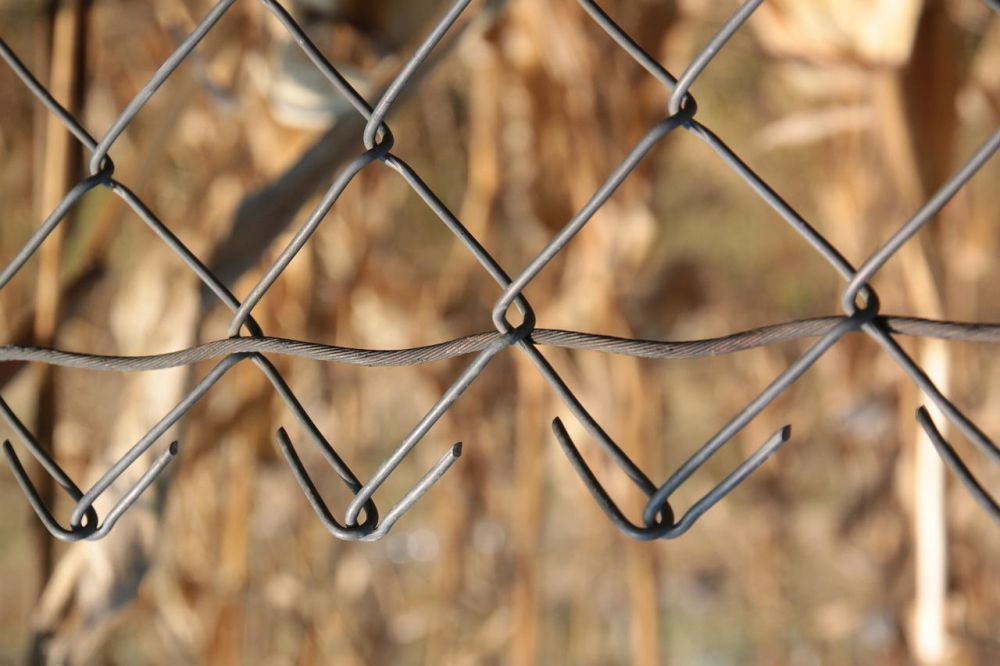
How to Secure a Chain Link Fence at the Bottom
If you’re hoping to use a chain link fence for security, there’s one question you’re probably asking yourself: how to secure a chain link fence at the bottom?
You’ve probably seen news stories where people climbed under a chain link fence that was intended for security. It certainly happens from time to time, but fortunately, there are several options you can use to secure a chain link fence at the bottom.
Why Do You Need to Secure Chain Link Fence at the Bottom?
Usually, chain link fence is installed with about 2” or 50mm of space below the bottom of the mesh. This is usually attached to a bottom wire using tie wire or hog rings. However, over time, wire and mesh can stretch, and that often means that there’s a little more “play” on the bottom wire than you would like. Especially a few years after it was installed!
This allows the bottom of the fence to be lifted more than it should be, and particularly if combined with some digging in the dirt below, makes a large enough space for people or animals to get through.
This has resulted in incidents like one at Edmonton International Airport in 2016, when someone climbed under the chain link fence to access the airport without authorization.
If you want a chain link fence to be as secure as possible, you definitely need to secure the bottom of the fence too.
Options to Secure a Chain Link Fence at the Bottom
The good news is that like most fencing challenges, there are many answers to the question of how to secure chain link fence at the bottom. These vary in complexity, cost and how much security they add, but we’ve listed a few of the options here, so you can see what you might be able to do to solve this problem.
Buried Mesh
One of the simplest ways to ensure that the bottom of your chain link fence is more secure is to bury about 12” or 30cm of the mesh in the ground.
It’s usually a good idea to treat the bottom of the mesh with a bitumen-based product, or with corrosion resistant paint. Even if the fence is galvanized, the acids and chemicals that naturally occur in soil, as well as the moisture in the ground will probably cause your mesh to rust prematurely. Applying one of these products will help to protect the fence.
To add a little extra security to the fence, you could mix some cement into the dirt used for backfilling and wet the fence line after installation. This will turn the dirt under the fence into a weak “mortar” and make it harder to access the buried portion of the mesh.
A Mesh “Skirt”
Sometimes, for whatever reason, you don’t want to bury the mesh of the fence itself. If that’s the case on your project, you could choose to bury a separate mesh “skirt” below the fence mesh and use hog rings or tie wires to attach it to the fence bottom wire or bottom rail.
In many cases, it’s a good idea to use cut to size sections of welded mesh instead of chain link mesh for this, because it’s more rigid, and easier to place in a trench below your fence.
Hooks and Pegs
Another option for securing the bottom of a chain link fence (or any other mesh fence for that matter) is to use hooks or pegs.
These are similar to the type of pegs you would use for tents and similar, and they are simply driven into the ground along the bottom of the fence.
Usually, these kinds of pegs would be long enough that they can’t be pulled out easily by hand, and they are usually installed about every 500mm or 20” along the fence line. This makes it very difficult, if not impossible, to lift the bottom of the fence.
Bottom Rails
Another option that answers the question of how to secure the bottom of a chain link fence is to have a bottom rail added to your fence.
Many chain link fence designs include a top rail that is made from a relatively small diameter pipe, secured with rail ends and brace bands, and passed through line post tops. However, when you install a bottom rail, you will usually need to use boulevard clamps to attach the rails to the bottom of the fence.
However, while this does stop the fence from being lifted up easily, it does not stop people or animals digging under the fence, so if you need to prevent that too, you might want to use another under fence security option.
When Should You Secure the Bottom of a Chain Link Fence?
Ideally, when you design a security fence, you would create a design that meets all your security needs from day one.
However, sometimes, you discover that the fence you’ve chosen is not quite up to the task after it is installed.
The good news is that it’s often possible to retrofit fences with additional security features after they have been installed. It will take additional labor to complete the work, particularly if there is trenching and backfilling to be done along the fence line.
However, if you need to prevent access by people or animals, and the bottom of your fence is a weak point, your options are to retrofit the fence, or install a new fence.
It’s a good idea to speak to a fence professional when making these kinds of decisions. Ask them to visit your site, so they can see the fence and the site conditions along your fence line in person. This will help them to design a solution to your problem of how to secure the bottom of a chain link fence for your particular site, and the type of fence you have.

